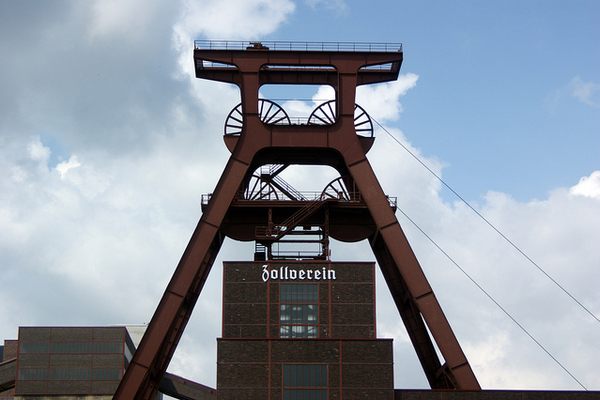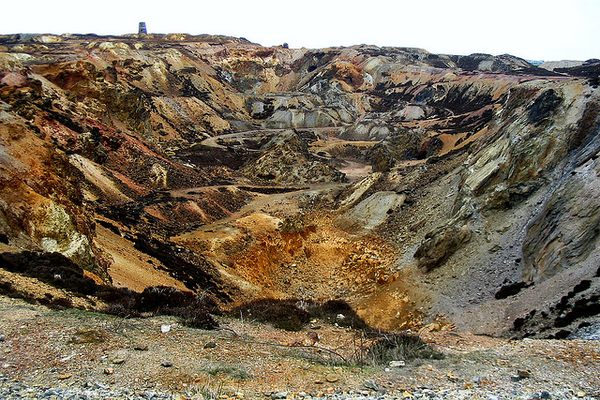Rust is Beautiful: A Tour Through Seven of Europe’s Awe-Inspiring Industrial Sites
“Magische Orte” installed in the Gasometer (photograph by Julian Schüngel)
There’s no doubt that the industrialization of Europe radically changed the landscape through massive brick factories and smokestacks churning into the skies. And when that industry moved on, it left behind relics with abandoned sprawling structures and rusting machines. The European Route of Industrial Heritage is aimed at celebrating the history, and even the beauty, of these monuments to the man-made.
The route includes sites in Belgium, Czech Republic, Denmark, France, Germany, Great Britain, Italy, Luxembourg, Netherlands, Norway, Poland, Spain, and Sweden, with themes organized around things like salt, water, mining, and iron and steel. The most recent addition is the Grossouvre Charcoal Hall in Val d’Aubois, France, which was added this June. That site is almost bucolic out in the French countryside, and the sites range from the monolithic factories to mines driven into the earth to museums like the Saxon Museum of Industry where the Chemnitz Tar Mummy is on display. That preserved body of an unknown workman discovered in a tar container in 1884 is a reminder of the often anonymous human labor behind each and every one of these stunning places.
Here are seven of the most striking sites on the European Route of Industrial Heritage:
FERROPOLIS
Gräfenhainichen, Germany
(photograph by drrisk/Flickr user)
Ferropolis, a “town of iron,” is a resting place for giant decommissioned building machines. The open air museum includes such wonders as the Racehorse, a 221 kilo crawler swing excavator, and for some you can even climb on board for a panoramic view.
(photograph by Krane Schneidewind)
(photograph by Juska Wendland)
(photograph by Felix Petersen)
(photograph by pixelchecker/Flicker user)
(photograph by Steffen Zahn)
BLEGNY-MINE
Blegny, Belgium
(photograph by Ton Nolles)
Mining in the Belgian River Maas goes back to as early as 1125, and the Blegny-Mine is a haunting monument to this coal heritage.
(photograph by Antonio Tonte)
GASOMETER
Oberhausen, Germany
(via Wikimedia)
The 1920s Gasometer Oberhausen gas holder was almost demolished in the 1990s when many saw it as a hideous mar on the cityscape, yet it was preserved and is now one of Europe’s most stunning art centers. It’s currently hosting a giant inflatable installation by Christo called “Big Air Package.”
Christo’s “Big Air Package” installed in the Gasometer (photograph by Felix Montino)
View of the Christo installation (photograph by Ulrich Heither)
PARYS MOUNTAIN
Amlwch, Wales
(photograph by Richard Pritchard)
The Parys Mountain is the industrial landscape of a copper mine that was incredibly active in the late 18th century, and was in fact the main source of copper for the British. It’s partly responsible for Nelson’s success at the Battle of Trafalgar where British ships were protected with copper from Parys Mountain.
(photograph by Steve Johnson)
(photograph by Eifion)
(photograph by Ben Cooper)
ZOLLVEREIN
Essen, Germany
(photograph by Jamie Koroluk)
Once the largest coal mine in Europe with around 5,000 employees, Zollverein is considered by many to be the “most beautiful coal mine in the world.” This is due largely to its architecture, done in a Bauhaus style with details of red over the towering machines. In 2001, it was put on the UNESCO World Heritage Sites list.
(photograph by Andrew Sweeney)
(photograph by Michele Gualco)
(photograph by Nietnagel/Flickr user)
(photograph by Nietnagel/Flickr user)
(photograph by Guy Gorek)
CORNISH MINING SITE
Cornwall, England
(photograph by Malcolm Osman)
The ruins lingering on the cliffs of Cornwall might look like bits of castles or churches, but they are actually the remains of mining operations going back to the Bronze Age, where tin and later copper were extracted from the earth.
Old ladders down into the mines (photograph by Uglix/Flickr user)
(photograph by Malcolm Osman)
VOLKLINGER HUTTE
Völklingen, Germany
(photograph by Marie/Flickr user)
Völklinger Hütte, an ironworks factory closed in 1986, was the first industrial monument ever designated as an UNSECO World Heritage Site. It was started back in the 19th century, and now visitors can walk through the massive, rusting machines still standing from its operations.
(photograph by Boris Doesborg)
(photograph by Steamtalks/Flickr user)
(photograph by Boris Doesborg)
Click here for more sites on the European Route of Industrial Heritage.











Follow us on Twitter to get the latest on the world's hidden wonders.
Like us on Facebook to get the latest on the world's hidden wonders.
Follow us on Twitter Like us on Facebook